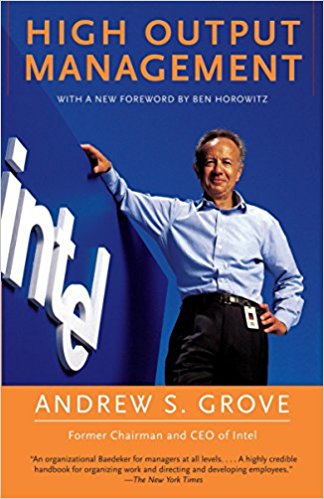High Output Management
This book was first published in 1983 and revised in 1995 by Andrew Grove who was the Chairman and CEO of Intel.
Some of the examples in the book show it's age. For example the impact of the introduction of email on mailroom managers is covered. Plans involved installing printers in the mail rooms of different locations so that the messages could then be distributed to staff at those locations.
This is in many ways a very different environment to the way businesses operate today. However this book is still as relevant as it ever was.
A new introduction was written for the 1995 edition which cites email as a critical event which altered the environment in which managers work. I first used email sporadically around 1992 at University.
Andrew saw that email and the wider information revolution had two implications, messages could be sent and received in minutes rather than days and that it was just as easy to reach dozens of co-workers as to reach one. Ironically these two characteristics are key contributors to the information overload many experience today.
The book suggests that as improved information flow allows employees to be more informed about what is going on in the business, there is less need for managers to disseminate information to their staff. This means that managers can effectively manage larger teams.
I wonder though, in the era of information overload, how effective sharing information in bulk via email or other electronic means is - how many people actually take the time to read and understand this. Rather than actively disseminating information, a modern manager should be monitoring and ensuring their staff are actively engaged with these messages and stay informed.
The introduction also notes that the impact of globalisation and faster information flow result in everything happening faster and that this results in a ‘less kind, less gentle and less predictable workplace’. To operate in this environment a manager needs to have a ‘high tolerance for disorder’. In a fast moving and changing environment disorder is inevitable - the manager should still work to create order, but needs to be prepared mentally and emotionally.
This is something I struggle with at times. When things are changing quickly and a little chaotic it can be very hard to understand what is going on. People working together will often have subtly different perspectives which are not fully understood by others, particularly where there is schedule pressure. Everybody is working to bring some order and may well be doing this in different ways, resulting in confusion and what may be perceived as ‘wasted effort’, at least in retrospect. I think that recognising that things are a little chaotic and that people’s perspectives and mental models of what is going on are different will be very helpful to create a useful picture of what is going on and maintain a positive frame of mind.
A key message of the book is that “the output of a manager Is the output of the organisational units under his or her supervisions and influence.” In order to maximise this output a manager need to undertake activities that have a high managerial leverage. The idea here is that spending your time on activities that have the most impact in terms of influencing others to improve their performance.
Contemporary business advice often talks about reducing the number of meetings and making sure these meetings have a clear operational focus and can not be accomplished some other way - such as sending out a status report. The book devotes a whole chapter to meetings and cites them as a key tool for managerial leverage.
Meetings are expensive, in terms of the time spend by participants. A 5 person meeting can easily cost £200/ hour or more so it is important that time is not wasted and the book offers practical tips to running different types of meetings effectively. If a meeting was worth the cost then minutes of the meeting should be created and distributed as soon as possible. This is a small relative investment which increases the value of the meeting to the organisation.
Meetings provide managers with an opportunity to influence the work of their staff by providing input and advice, perspective and describing preferred ways of handling things. This is much harder to achieve if meetings are replaced with written status reports.
The book also covers other topics including Decision Making, Planning, Organisation Structure and Dual Reporting, Performance management and Training. For now, I have spent as much time as I can on this and will follow up on these soon!
